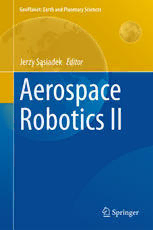
Aerospace Robotics II PDF
Preview Aerospace Robotics II
GeoPlanet: Earth and Planetary Sciences Jerzy Sąsiadek Editor Aerospace Robotics II GeoPlanet: Earth and Planetary Sciences Editor-in-chief Paweł Rowiński Series editors Marek Banaszkiewicz, Warsaw, Poland Janusz Pempkowiak, Sopot, Poland Marek Lewandowski, Warsaw, Poland Marek Sarna, Warsaw, Poland More information about this series at http://www.springer.com/series/8821 ą Jerzy S siadek Editor Aerospace Robotics II 123 Editor Jerzy Sąsiadek Mechanical and Aerospace Engineering Carleton University Ottawa, ON Canada The GeoPlanet: Earth and Planetary Sciences Book Series is in part a continuation of Monographic Volumes of Publications of the Institute of Geophysics, Polish Academy of Sciences, thejournal published since1962(http://pub.igf.edu.pl/index.php). ISSN 2190-5193 ISSN 2190-5207 (electronic) GeoPlanet: Earth andPlanetary Sciences ISBN 978-3-319-13852-7 ISBN 978-3-319-13853-4 (eBook) DOI 10.1007/978-3-319-13853-4 LibraryofCongressControlNumber:2013932857 SpringerChamHeidelbergNewYorkDordrechtLondon ©SpringerInternationalPublishingSwitzerland2015 Thisworkissubjecttocopyright.AllrightsarereservedbythePublisher,whetherthewholeorpart of the material is concerned, specifically the rights of translation, reprinting, reuse of illustrations, recitation, broadcasting, reproduction on microfilms or in any other physical way, and transmission or information storage and retrieval, electronic adaptation, computer software, or by similar or dissimilarmethodologynowknownorhereafterdeveloped. The use of general descriptive names, registered names, trademarks, service marks, etc. in this publicationdoesnotimply,evenintheabsenceofaspecificstatement,thatsuchnamesareexempt fromtherelevantprotectivelawsandregulationsandthereforefreeforgeneraluse. Thepublisher,theauthorsandtheeditorsaresafetoassumethattheadviceandinformationinthis book are believed to be true and accurate at the date of publication. Neither the publisher nor the authors or the editors give a warranty, express or implied, with respect to the material contained hereinorforanyerrorsoromissionsthatmayhavebeenmade. Printedonacid-freepaper Springer International Publishing AG Switzerland is part of Springer Science+Business Media (www.springer.com) Series Editors Geophysics Paweł Rowiński Editor-in-Chief Institute of Geophysics Polish Academy of Sciences ul. Ks. Janusza 64 01-452 Warsaw, Poland [email protected] Space Sciences Marek Banaszkiewicz Space Research Centre Polish Academy of Sciences ul. Bartycka 18A 00-716 Warsaw, Poland Oceanology Janusz Pempkowiak Institute of Oceanology Polish Academy of Sciences Powstańców Warszawy 55 81-712 Sopot, Poland Geology Marek Lewandowski Institute of Geological Sciences Polish Academy of Sciences ul. Twarda 51/55 00-818 Warsaw, Poland Astronomy Marek Sarna Nicolaus Copernicus Astronomical Centre Polish Academy of Sciences ul. Bartycka 18 00-716 Warsaw, Poland [email protected] Managing Editor Anna Dziembowska Institute of Geophysics, Polish Academy of Sciences Advisory Board Robert Anczkiewicz Bertrand Fritz Research Centre in Kraków Ecole et Observatoire des Institute of Geological Sciences Sciences de la Terre, Kraków, Poland Laboratoire d’Hydrologie et de Géochimie de Strasbourg Aleksander Brzeziński Université de Strasbourg et CNRS Space Research Centre Strasbourg, France Polish Academy of Sciences Warsaw, Poland Truls Johannessen Geophysical Institute Javier Cuadros University of Bergen Department of Mineralogy Bergen, Norway Natural History Museum London, UK Michael A. Kaminski Department of Earth Sciences Jerzy Dera University College London Institute of Oceanology London, UK Polish Academy of Sciences Sopot, Poland Andrzej Kijko Aon Benfield Evgeni Fedorovich Natural Hazards Research Centre School of Meteorology University of Pretoria University of Oklahoma Pretoria, South Africa Norman, USA Francois Leblanc Wolfgang Franke Laboratoire Atmospheres, Milieux Geologisch-Paläntologisches Institut Observations Spatiales, CNRS/IPSL Johann Wolfgang Goethe-Universität Paris, France Frankfurt/Main, Germany Kon-Kee Liu Tilman Spohn Institute of Hydrological Deutsches Zentrum für Luftund and Oceanic Sciences Raumfahrt in der Helmholtz National Central University Jhongli Gemeinschaft Jhongli, Taiwan Institut für Planetenforschung Berlin, Germany Teresa Madeyska Research Centre in Warsaw Krzysztof Stasiewicz Institute of Geological Sciences Swedish Institute of Space Physics Warsaw, Poland Uppsala, Sweden Stanisław Massel Roman Teisseyre Institute of Oceanology Earth’s Interior Dynamics Lab Polish Academy of Sciences Institute of Geophysics Sopot, Polska Polish Academy of Sciences Warsaw, Poland Antonio Meloni Instituto Nazionale di Geofisica Jacek Tronczynski Rome, Italy Laboratory of Biogeochemistry of Organic Contaminants Evangelos Papathanassiou IFREMER DCN_BE Hellenic Centre for Marine Research Nantes, France Anavissos, Greece Steve Wallis Kaja Pietsch School of the Built Environment AGH University of Science Heriot-Watt University and Technology Riccarton, Edinburgh Kraków, Poland Scotland, UK Dušan Plašienka Wacław M. Zuberek Prírodovedecká fakulta, UK Department of Applied Geology Univerzita Komenského University of Silesia Bratislava, Slovakia Sosnowiec, Poland Barbara Popielawska Space Research Centre Polish Academy of Sciences Warsaw, Poland Preface I Dear Colleagues and Friends, Space robotics is a fascinating field that was developed for space exploration and space missions. Space is a hostile environment for humans and could not be exploredearlier because oftechnologicalfactors.Simply speaking,ourtechnology inthepastwasnotadvancedenoughtoallowustoventuresafelyintospace.Also, in many cases, traveling in space takes more than a human’s life span. This is exactlythereasonwhywehavetouserobotsofavarietyofsortsandtypes.Robots allowhumanstoextendtheirabilitiestoperformmissionsthatotherwisewouldbe dangerous or simply impossible. Robots make long-duration missions not only possiblebutalsopresentopportunityforexplorationofthesolarsystemsafelyand efficiently. The space automation and autonomous missions are also a viable solution to deep space travel and exploration problems. One of the issues that needs urgent solution is the problem of space debris removalfromEarthhighorbits.Oneoftheviablepossibilities istheapplicationof robotics including spacecraft base with two-arm manipulator. It is with great pleasure that we would like to show once more to the interna- tionalspaceroboticscommunity,selectedpaperspresentedattheIIConferenceon Aerospace Robotics held in Warsaw, Poland during 1–2 July 2013. We have selected 18 papers from the conference that reflect the interests and topicsofallpaperspresentedatthisconference.Thisbookincludespapersranging from space manipulators control and applications to mobile robots and sample taking instrumentation. We hope that our readers will find these papers not only interesting but also helpful and inspiring in their professional activities. Warsaw, June 2014 Marek Banaszkiewicz Jerzy Sąsiadek ix
